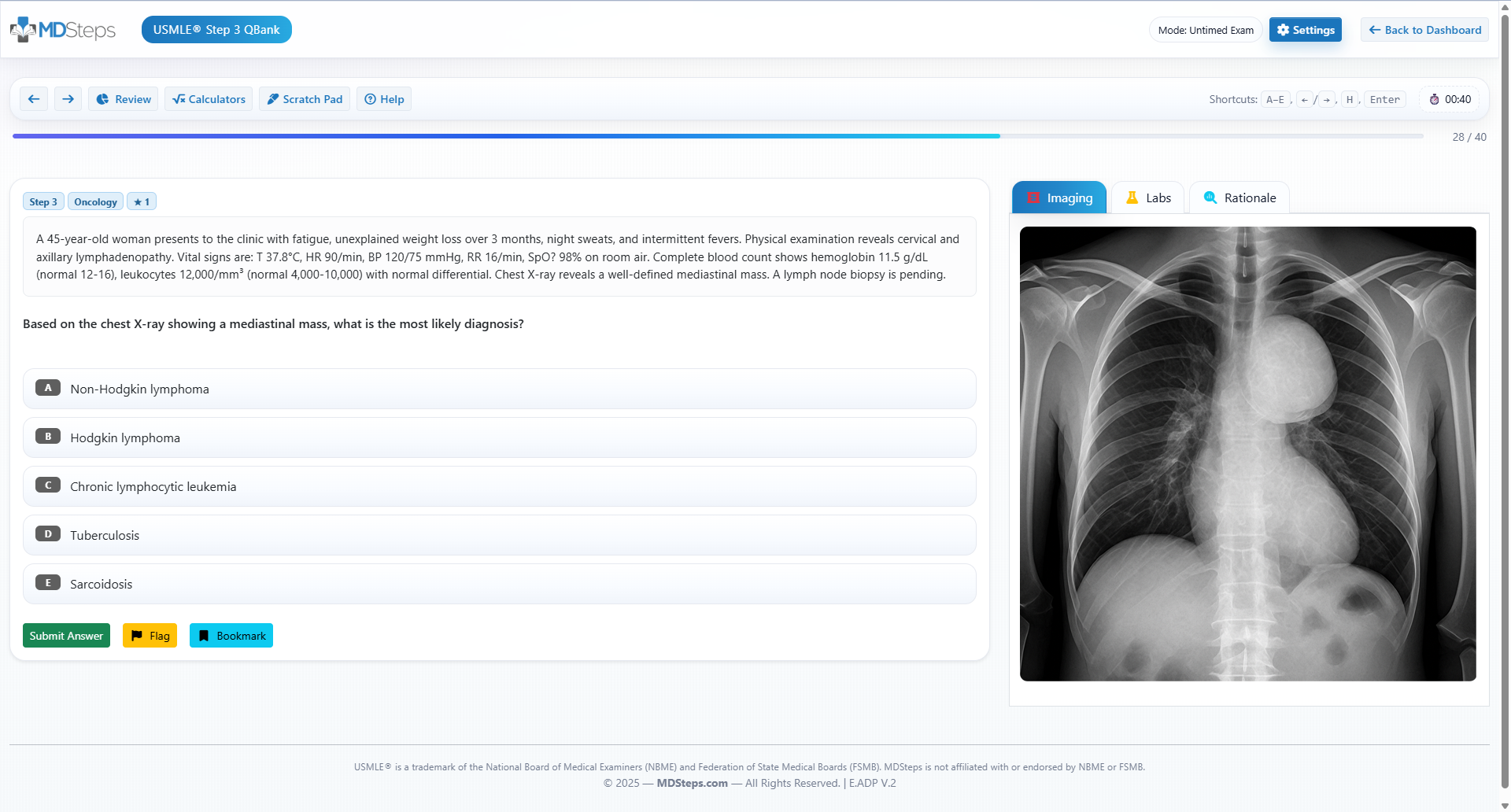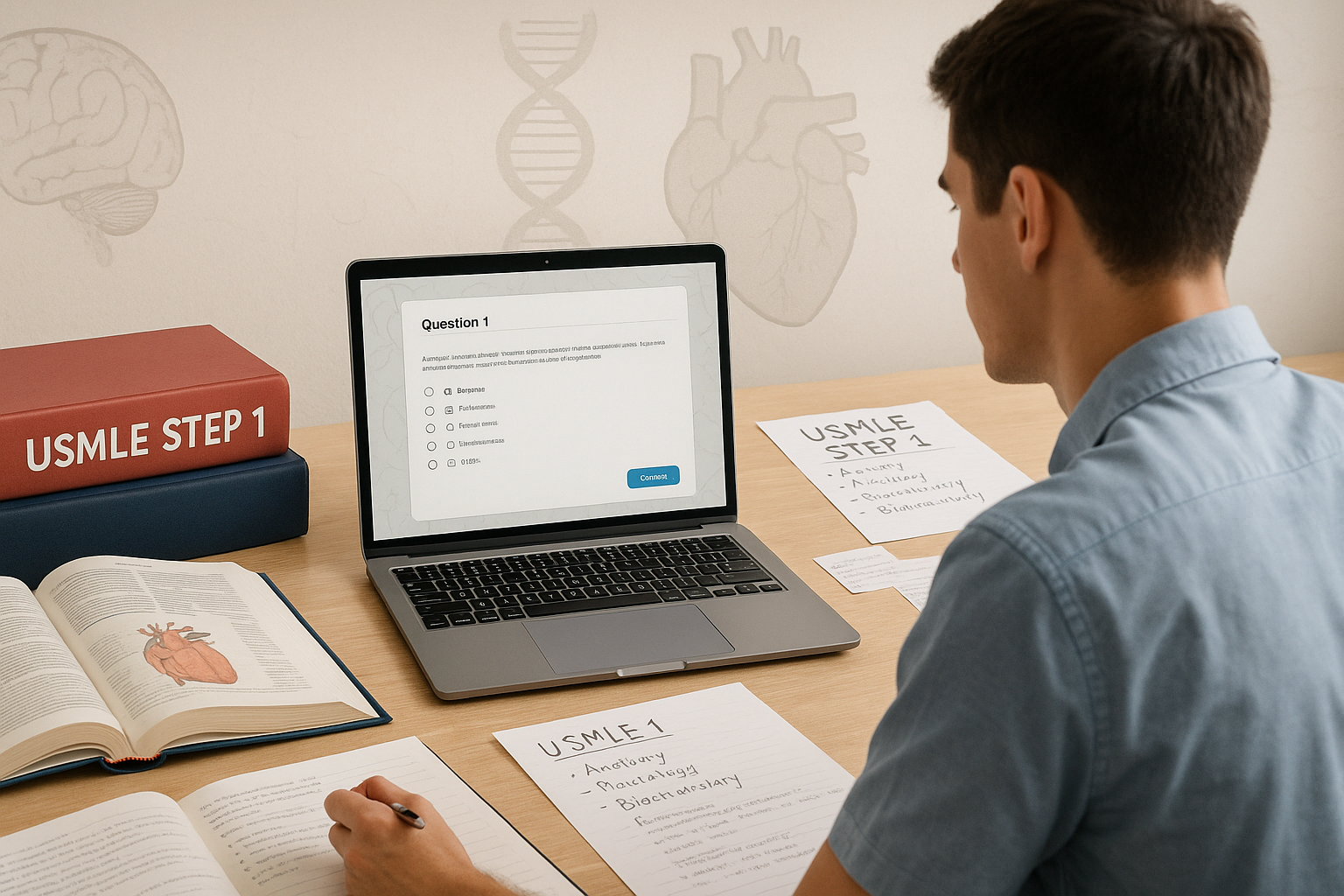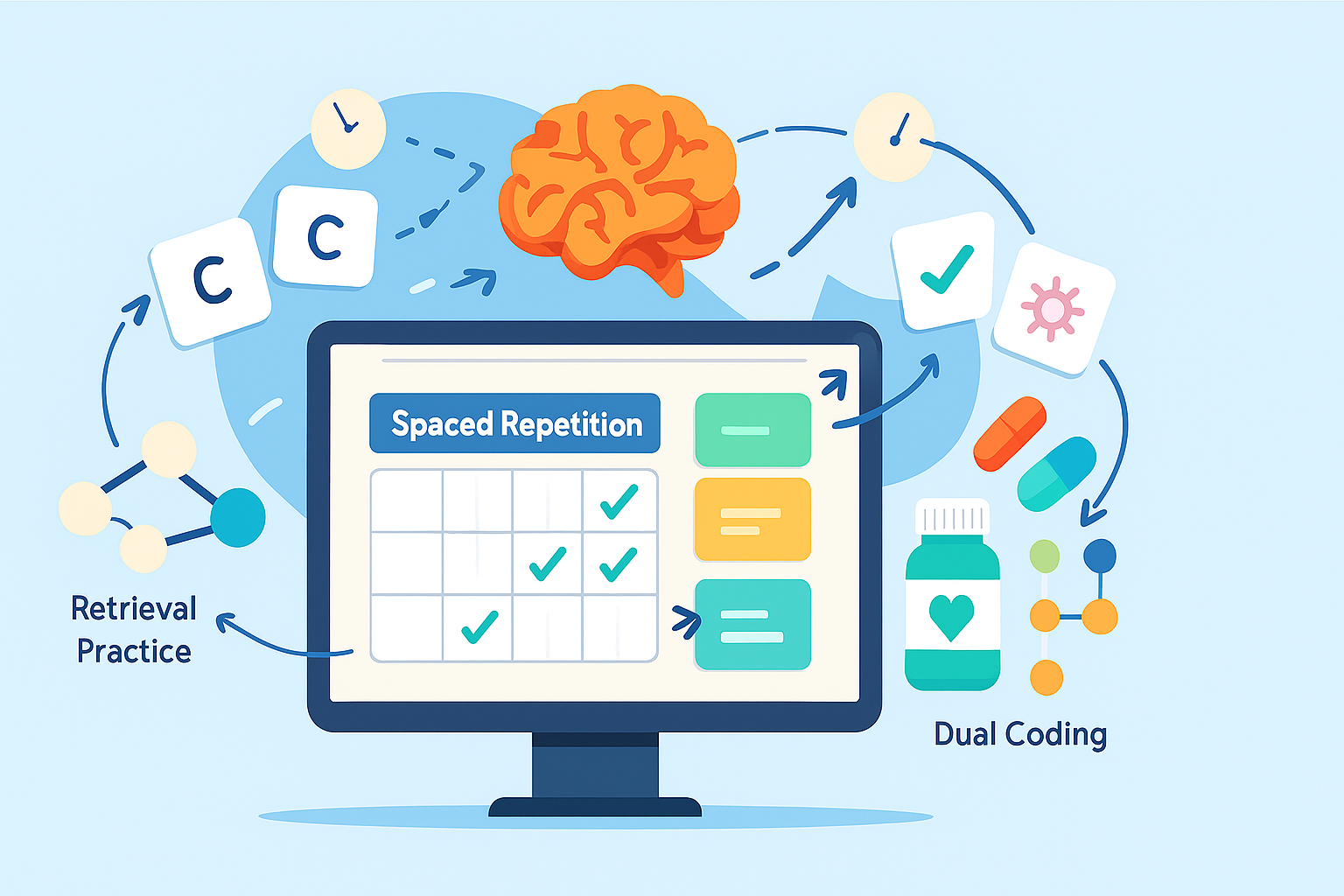Master your USMLE prep with MDSteps.
Practice exactly how you’ll be tested—adaptive QBank, live CCS, and clarity from your data.
- Adaptive QBank with rationales that teach
- 50+ CCS cases with live vitals & scoring
- Progress dashboard with readiness signals
Choose Your Track: Pass, 230-Aim, or 250-Aim
Four weeks is short enough to demand ruthless prioritization and long enough to make meaningful score movement if you execute with discipline. Start by fitting your effort to your target. The Pass track emphasizes core mastery, high-yield systems, and ruthless error-pattern targeting. The 230-aim track layers higher daily volume, tighter review loops, and weekly mixed blocks to consolidate transfer across disciplines. The 250-aim track adds double blocks, aggressive active recall, and frequent mixed-mode challenges that mimic the cognitive switching of the real exam.
Pick the track that matches your current NBME baseline and bandwidth. If your latest practice form is within ~10–15 points of your target, choose the higher track; otherwise pick the lower track, execute perfectly for 7–10 days, then reassess. Changing tracks isn’t failure—it’s strategic calibration. The key is consistency, not heroics.
| Daily Target | Pass | 230-Aim | 250-Aim |
|---|---|---|---|
| AM Q-Blocks (Timed, Mixed) | 1 × 40 | 1–2 × 40 | 2 × 40 |
| PM Review (Error-driven) | 2–3 hrs | 3–4 hrs | 4+ hrs (tiered) |
| Spaced Recall (Micro-Anki) | 20–30 min | 30–45 min | 45–60 min |
| Content Refresh (MDSteps) | 0.5 hr targeted | 0.5–1 hr targeted | 1 hr targeted |
| Assessments (Weekly) | Mini (20–40 Q) | Mini + 1 form (wk 2–3) | Mini + 2 forms (wk 2–4) |
Whichever track you choose, keep the block quality high: timed, mixed, and first-pass honest—no peeking, no mid-block Googling, no pausing for notes. Your learning comes from the gap between what you thought and what was asked. That error signal powers the PM review loop below.
Daily Cadence: AM Questions, PM Review, Micro-Anki
Lock a predictable rhythm to conserve willpower. Mornings simulate exam conditions when alertness is strongest. Afternoons convert mistakes into durable memory traces. Evenings leverage short spaced-recall “micro-bursts” to keep facts retrievable without exhausting you.
- AM (2–3.5 hrs): Timed, mixed question block(s) per your track. Use “exam rules”: 90 seconds/question average, mark if needed, move on. Record only question # and brief hypothesis if time allows.
- Midday (30–45 min): Walk/stretch + high-protein snack. No content. Let consolidation begin.
- PM (3–5 hrs): Tiered review: (1) Reconstruct stem & why each distractor is wrong; (2) Extract testable pivot (the discriminating detail) into a concise note; (3) Create 1–2 micro-cards for persistent errors; (4) Read a focused MDSteps summary for your top two weak systems.
- Evening (20–60 min): Micro-Anki review targeting leeches (items you repeatedly miss). Cap at your track’s limit to avoid review debt.
Time-box each step. Over-reviewing a single tough question steals from broad coverage and reduces transfer. Your rule: depth until the rule emerges, then move. If you cannot articulate the rule (“When X in a febrile neonate, do Y first”), the review isn’t done. If you can, stop polishing.
Finally, protect sleep. Memory consolidation depends on it, and question performance the next morning will mirror your prior night’s recovery. Treat bedtime like a non-negotiable deadline. If you’re behind, shrink content review, not sleep.
A 28-Day Macro Plan: Weekly Themes & Targets
Structure the month so each week emphasizes transfer across systems while circling back to high-yield neuro, cardio, renal, micro, pharm, and biostats/ethics. The goal is successive refinement: broader mix in practice with increasingly precise rules in review. Use the matrix below to know what “done” looks like each week.
| Week | System Emphasis | Mixed Blocks | Assessments | Content Refresh (Targeted) |
|---|---|---|---|---|
| Week 1 (Days 1–7) | Neuro, Cardio, Renal | 4–10 blocks (by track) | Day 7 mini (40Q) | 2–3 MDSteps briefs |
| Week 2 (Days 8–14) | GI, Heme/Onc, Endo | 4–10 blocks | 1 form (230/250); mini for Pass | 2–3 briefs + formula sheet |
| Week 3 (Days 15–21) | Micro, Pharm, Repro | 4–10 blocks | 1 form (all tracks) | Bug–Drug pairs; tox antidotes |
| Week 4 (Days 22–28) | Biostats/Ethics, Rapid Mix | 4–10 blocks | Final form (Day 25–26) | Error log & rule deck |
Weekly themes guide your targeted PM reading and micro-card creation. Mixed blocks remain the default every day to train switching costs and reduce context-dependent performance. Your assessment cadence anchors each week and informs the coming one. If a mini-assessment reveals a weak domain (e.g., endocrine lab interpretation), schedule a 45-minute content refresh plus 10 micro-cards the next day.
Weekly Checkpoints: Mini-Assessments & Rotating Weak Areas
Checkpoints are not just score snapshots; they are decision points. Each week culminates in a brief timed assessment (20–40 mixed items) and—on selected weeks—an NBME-style form under exam conditions. Use a simple three-color rubric to convert results into action:
Green (≥ target)
Maintain current volume. Convert correct-but-uncertain items into micro-cards. Avoid “victory laps.”
Yellow (-5 to -10)
Add one 45-min focused review on that domain next day; keep mixed blocks intact.
Red (<-10)
Schedule a 90-min rescue session (MDSteps brief → worked examples → micro-cards). Replace one content block, not question blocks.
Rotate weak areas explicitly. After each checkpoint, choose a single “spotlight domain” for the upcoming week and write a rule deck: 10–15 crisp, action-oriented statements (e.g., “Hyponatremia + high urine osmolality → SIADH; next test: serum uric acid; initial therapy: fluid restriction”). Use these rules to frame your PM reviews so they become faster and more transferable.
When using full forms mid-plan, simulate test day: start time, breaks, water/snacks, and no pausing. Score is only half the story; read the item-level breakdown for process errors (misreads, premature closure, data-anchoring). Fix process first, facts second—process errors leak points everywhere.
Rest-Day Rules & the Catch-Up Protocol
Deliberate rest is a performance tool, not an indulgence. You will take two true rest days across the 28 days: Day 14 and Day 27 (flexible ±1). On rest days, avoid question blocks and heavy content. Allow only: light movement, 20–30 minutes of micro-Anki for leeches if anxiety is high, and 15 minutes to tidy your desk and planner. Protect sleep with an early cutoff for screens.
Falling behind is expected. The Catch-Up Protocol prevents backlog from snowballing:
- List what slipped (e.g., “Review 14 questions from AM block; micro-cards for renal.”)
- Score each item 0–2 by impact (2 = exam-critical, 0 = nice-to-do).
- Allocate a 60-minute catch-up slot on the next two days (not rest day).
- Execute the top ≤3 items per slot using a timer. Anything left becomes optional.
Never compress tomorrow’s AM block to pay for yesterday’s review. Question practice drives learning signal; review tunes it. If you must borrow time, borrow from content reading or cap micro-cards. Your planner serves you best when it preserves the engine of progress: timed, mixed questions + targeted error repair.
Spaced Recall & Micro-Cards: Make Memory Retrievable
Short, frequent recall beats long, infrequent rereads. Use micro-cards as the smallest unit of memory investment. Each card should encode a testable pivot or a rule, not a paragraph. Example: “Diabetic with gastroparesis + persistent hypoglycemia → switch from prandial insulin to basal + metoclopramide.” Avoid cloze-deletions that hide the rule you need to say out loud on test day.
- Daily cap: Stay within your track’s limit to avoid review debt.
- Leech handling: If an item fails 3–4 times, rewrite it. If it still fails, schedule a 10-minute targeted read + single worked example.
- Interleaving: Mix pharmacology mechanisms with clinical vignettes and path images. Retrieval under varied cues improves transfer to novel stems.
Use your evening micro-Anki block to maintain recall without draining willpower. Tag cards by system and error type (misread, content gap, reasoning). In your weekly review, sort the “reasoning” tag and write 2–3 process rules (e.g., “Always check vitals trend before labs in shock stems”). The goal is to make the right step feel obvious under time pressure because you have rehearsed the rule, not because you remember a factoid.
Daily Timeboxing & Energy Management
Fatigue masquerades as knowledge gaps. Preserve decision-quality by scheduling cognitively heavy work when you’re freshest and guarding break hygiene. Use 50–60 minute focus intervals with a 5–10 minute movement break. Keep caffeine steady (early AM and late AM only) to avoid afternoon crashes. Hydration and protein forward meals (breakfast & lunch) stabilize attention during blocks.
Build a start ritual: noise-free environment, phone in another room, scratch paper, and timers pre-set. Eliminate friction so the first question is on screen within 2 minutes of sitting down. For PM review, open your error log first and sort by “highest leverage.” If willpower is low, do a 10-question “warm-start” review before diving into long stems.
Close the day with a shutdown routine: list top 3 priorities for tomorrow, set alarm, lay out snacks/water, and glance at the weekly matrix to confirm alignment. This 10-minute investment reduces rumination and improves sleep onset—indirectly raising tomorrow’s score.
Rapid-Review Checklist (Days 24–28)
The final five days tighten execution rather than adding volume. Keep your AM blocks, shorten content reading, and aim your attention where points still leak. Use this checklist each evening:
- ⏱️ Sim conditions: One block timed, no pausing, with break practice.
- 🧭 Error log sweep: Top 15 recurring pivots (electrolytes, murmurs, rashes, tox, renal acid-base) — articulate the rule aloud.
- 📊 Biostats drill: 10 rapid CI/sensitivity/specificity items; write formulas from memory.
- 💊 Pharm map: Autonomics, antibiotics (MOA/tox), endocrine drugs; update bug–drug pairs.
- 🧪 Labs cheat: Anion gap, osmolar gap, acid–base, urine Na/FENa; rehearse first steps.
- 🧠 Process rules: “Read the last sentence first,” “Re-read stem pivot after choices,” “Eliminate by mechanism mismatch.”
- 🛌 Sleep protection: No new topics after 8 pm; micro-Anki only if calm.
On Day 25–26, take your final form if indicated, then focus the remaining days on rule reinforcement and light mixed practice. The night before the exam, stop heavy content. Pack, review break timing, and rehearse your opening 10-question pacing plan. Confidence is built on preparation, not last-minute cramming.
Putting It Together: A Sample Day for Each Track
Use these templates as a starting point. Adjust times to your circadian peak, but keep the structure.
| Time | Pass | 230-Aim | 250-Aim |
|---|---|---|---|
| 08:00–09:30 | Block (40Q) | Block (40Q) | Block 1 (40Q) |
| 09:30–09:45 | Break | Break | Break |
| 09:45–11:15 | — | Light review start | Block 2 (40Q) |
| 11:15–12:00 | Snack/walk | Snack/walk | Snack/walk |
| 12:00–15:00 | Tiered review | Tiered review | Tiered review (deeper) |
| 15:00–16:00 | MDSteps brief (weak sys) | MDSteps brief + examples | MDSteps brief + rule deck |
| 16:00–16:20 | Break | Break | Break |
| 16:20–17:00 | Micro-Anki (20–30m) | Micro-Anki (30–45m) | Micro-Anki (45–60m) |
| Evening | Shutdown routine | Shutdown routine | Shutdown routine |
If life intervenes, revert to the day’s minimum viable plan: one timed 40-question block, 90 minutes of error-focused review, and 20 minutes of micro-Anki. Hitting the minimum every single day will outperform sporadic hero days followed by burnout.
References & Further Reading
- Bjork R, Bjork E. Desirable difficulties in theory and practice. UCLA Bjork Learning & Forgetting Lab.
- Cepeda NJ, et al. Spacing effects in learning: A temporal ridgeline of optimal retention. Psychological Science.
- Roediger HL, Karpicke JD. Test-enhanced learning: Taking memory tests improves long-term retention. Perspectives on Psychological Science.
- Sweller J. Cognitive load theory. Educational Psychology Review.
- NBME. Examinee Guide & information on exam logistics. nbme.org.







